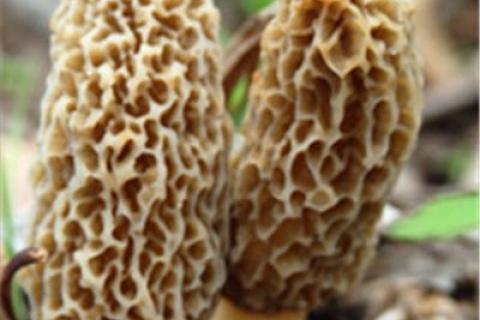
Spring is morel mushroom season. Hunters of the prized fungi will be out in force as the spring rains come and the nights begin to warm. Grizzled old 'shroom hunters will return from their hunts with bags full of the prized morsels like they have done for decades. Others will struggle to find enough morels for a single meal.
To successfully find these mushrooms, one must understand their macro and micro habitats, navigate the woods and see through camouflage. All are traits of a good explorer.
| Tip: "False morels," while sometimes can be consumed without ill effects, have been known to cause acute toxicity. The cap of the false morel appears wrinkled or "brainy," while real morels have honeycomb or net-like caps. An easier way to determine their difference: When the stem is cut open, false morels contain a cotton ball-type substance, while stems of the real kind are hollow. |
Good table fare is a motivator of many morel hunters. Others seek the thrill of finding new places, traversing new terrain and experiencing new vistas. Regardless of motivation, morel hunting is a good excuse to get outside and explore.
To find morels, you must have an understanding of their habitats and behaviors. The mushroom itself is a fruit of a much a larger system of thousands of miles of strands of underground mycelia. Of particular interest is the fact that, unlike plants, mushrooms are sexual entities. An individual spore can sprout and grow its mycelium, but it cannot reproduce until it mates with a compatible mycelium. Once mated, it can produce mushrooms and they, in turn, distribute spores to continue the process. The mycelia typically produces mushrooms when it is stressed. Production is its effort to sustain the race by producing offspring.
![]() Tip: Check out this revealing paper on SPRING MORELS AND FALSE MORELS OF MIDCONTINENTAL U.S. by H uffman & Tiffany, December 2001
Tip: Check out this revealing paper on SPRING MORELS AND FALSE MORELS OF MIDCONTINENTAL U.S. by H uffman & Tiffany, December 2001
5 Morel Mushroom Habitats and Behaviors
1. Mushrooms tap into tree roots to obtain nourishment while providing nutrients to the tree. This symbiotic relationship is beneficial to both. When the tree dies, such as in a forest fire, the mycelia becomes stressed from the loss of its food supply and produces mushrooms in an effort to put spores in the air that can be blown to more hospitable habitats. Stressors that lead to mushroom production are key factors to finding morel mushrooms. Burned over areas are great places to start.
2. Areas that have been logged are also good places to look for morels. The drastic increase in dead tree root systems may cause a morel bloom. It is not unusual to find hundreds of morels in such places.
3. Areas where the soil has been disturbed are also excellent micro-habitats for morels. The ruts of logging equipment are good places to look, as are the dirt mounds from pushed over trees. One of the most productive areas I ever found was the dirt spoil banks from county road ditches that were covered with silver maple trees.
4. Morels need lots of moisture. Look in low areas and spots that may hold a little extra moisture. Brush piles that have rotted down also provide small, damp spots that will hide morels.
5. Morels grow from the ground, not from trees and logs like other mushrooms. Because of their color, they blend into leaf litter and twigs, making them tough to spot with an untrained eye.
Morels are a supreme delicacy. If you want your spot to continue producing for years to come, harvest morels conservatively and correctly. The old adage of "leaving some for seed" is important to the future of the colony. When harvesting, clip the mushrooms off just above the ground without disturbing the root system. These practices will insure your bounty for the future.
- 7027 views

